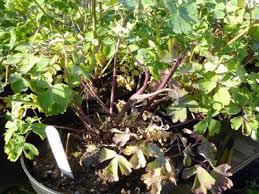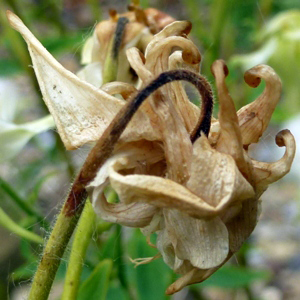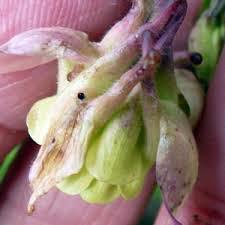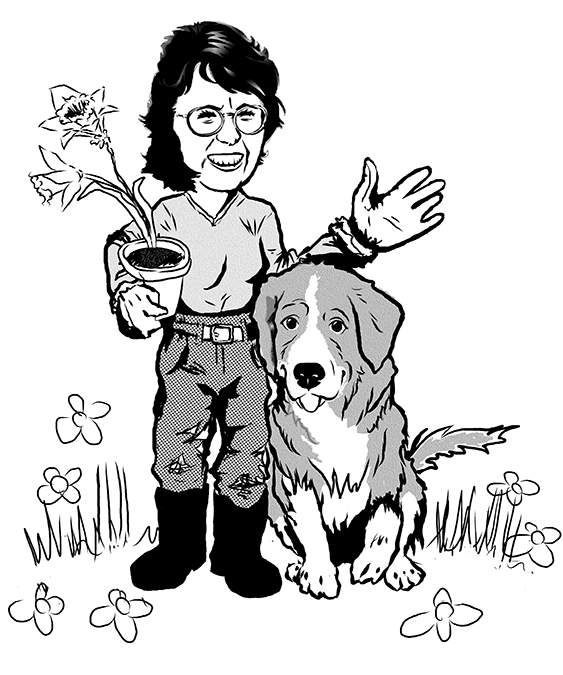Primula vulgaris ‘Kerbelnec’
Mustard ‘Komatsuna’
|
Brassica rapa var. perviridis Family: Brassicaceae |
|
|
Days to Maturity: From seed – 20 days (baby greens); 40 days (full size)
Description: A biennial leafy Asian green. Moderately elliptical, dark green leaves are grown on a long stem. They are slightly textured with veining quite prominently displayed. Although a biennial, this is considered a cool season crop, although it can tolerate short periods of extreme heat. It is reasonably frost-hardy to temperatures as low as -18 °C to -12 °C (0 °F to 10 °F). Protection with row cover or in a hoop house at the low temperatures is recommended.
Special Notes: An open-pollinated variety native to Japan, Korea, and Taiwan, this mustard is closely related to cabbage, turnips, rapini, and bok choi. Originally grown exclusively in its native countries, it was introduced into North America in the 1930s but has only recently gained some popularity in the specialty markets. Fast growing at optimum soil temperature, komatsuna can be harvested for baby greens at 20 – 30 days from seeding. Matures to full size in 40 days. Leaves have good nutritional value, rich in beta carotene, calcium, and Vitamins A, B2, C, and K. Also highly prized for its glucosinolates…sulfur-containing compounds found in brassicas which are generally thought to have great benefits in fighting cancer.
How to Grow: Optimum soil temperature range: 7 °C – 35 °C (45 °F – 95 °F). Minimum soil temperature: 4.5 °C (40 °F). Ideal soil temperature: 29.5 °C (85 °F). Ideal soil pH: 6.0 – 6.5. Amend planting row with Complete Organic Fertilizer (click here for recipe)…one cup (250 ml) per ten feet (3 m). If starting indoors, sow seeds from early February through to early March. If direct seeding outdoors, sow undercover for frost protection. From March through to the end of May, direct sow short rows every 2 – 3 weeks to ensure a continuous harvest of baby greens or mature plants. Start sowing again in late August or early September for late fall and winter harvests. Cut individual leaves or the whole plant at whatever maturity stage you prefer. Young leaves are tender with a gentler flavour than the tougher mature ones. If left too long, mature leaves can develop a slight bitterness. Use in salads, stir fries, soups, or as a steamed vegetable like spinach. Can be dried for longer storage in an air-tight container in a dry cool place.
Pests & Diseases: Slugs and wood lice (sow bugs) can be a problem for young seedlings. Good housekeeping in keeping rows debris-free with no puddles of water should help with these two pests. Flea beetles are attracted to the more mature leaves, leaving tiny round holes in their wake. Using row cover will guard against this pest. As with every member in the Brassicaceae family, clubroot is of major concern to komatsuna. Keeping to a strict regime of rotating your crops annually in a four or five year cycle…and not sowing another brassica crop where you grew one the year before is paramount to keeping clubroot out of your garden.
In our Zone 7a garden: We grew komatsuna for the first time in 2017. It grew well for us in our vegetable garden, which is in full sun…although some sections are shaded by a tall birch tree during part of the day. First planting was in the area which enjoys part shade through the heat of the day. This siting certainly delayed the komatsuna plants from bolting by a couple of weeks, at least, during the high heat of summer. We enjoyed the addition of young leaves in our salads so will definitely be growing this variety again in 2018. This time I will be experimenting in seeding a low pot of komatsuna…both green and the new hybrid red variety…to grow on my front porch which enjoys filtered sun.
Posted on February 21, 2018
|
|
Peronospora spp. – Aquilegia Downy Mildew (ADM)
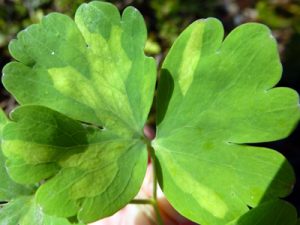 |
Peronospora spp. Family: Peronosporaceae Plant affected: Aquilegia (columbine) |
|
Aquilegia downy mildew (ADM) is spread by air- and water-borne spores. Can be carried long distances by the wind. Outbreaks typically occur when there are prolonged periods of rain in spring and/or late summer. Ideal conditions for production of spores and infection. While the airborne spores are only viable for a short time, the fungus is capable of producing a second type, called a resting spore, between the leaf tissues. These resting spores are more resilient. Released into the soil from decaying diseased material they can survive for several months, and perhaps for several years although this fact has not been confirmed.
The disease is so new, scientists have yet to assign a species name to the genus. While it has been placed in the same genus (Peronospora) as powdery mildew which also affects aquilegias, it is not related…despite certain similarities in symptoms.
Remedial Action: There is no chemical control for this disease. However, strict attention to hygiene in the prompt removal of any diseased parts or whole plants, as a non-chemical control method, will reduce the risk of resting spores contaminating the soil. Immediately burn diseased plants, or bag them for garbage removal. DO NOT COMPOST. The Royal Horticultural Society (RHS) has recommended not re-planting aquilegias in an affected area of the garden for at least a year. This advice may not have merit as there other species of Peronospora affecting other plant species which produce resting spores capable of surviving several years in the soil. Read more about Aquilegia Downy Mildew (ADM) in my Blog dated March 1, 2017. (Quick link here.)
Posted on February 14, 2018 |
|
Galanthus nivalis
Helleborus net necrosis virus – hellebore black death


